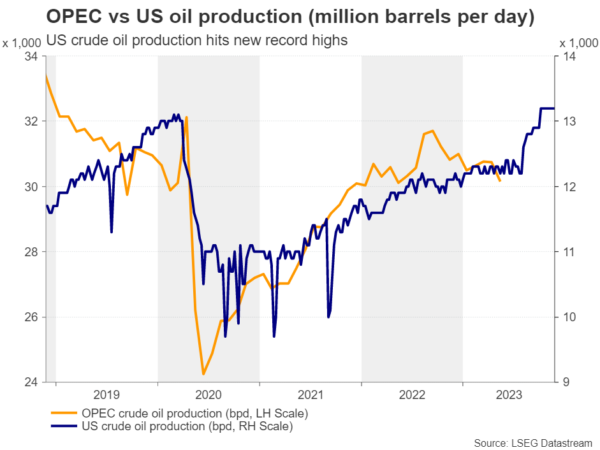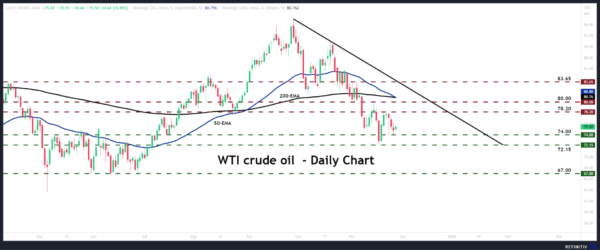- Oil prices slide after OPEC+ alliance delays meeting
- But recent headlines point to consensus
- Oil prices could gain, but any recovery may prove limited
- The meeting was postponed from Sunday to this Thursday
OPEC+ delays decision on lack of consensus
Oil prices tumbled after OPEC and other major oil producing nations, known as the OPEC+ group, decided to delay a meeting scheduled for Sunday, November 26, to Thursday, November 30. Investors may have sold black gold on concerns that the group was unable to reach consensus on further production cuts amid a weakening global growth outlook, as it was anticipated heading into the meeting.
Sources said that this was due to African countries Nigeria and Angola aiming for higher oil output allowance, as they were earlier given lower targets after years of failing to meet the previous ones. Nonetheless, on Friday, news hit the wires that the alliance has moved closer to a compromise, which increases the likelihood of having a consensus on Thursday.
Are deeper cuts on the table?
Before the announcement of the postponement, it was largely anticipated that members are likely to extend or even deepen the existing supply cuts into next year. Saudi Arabia was also expected to stretch its additional voluntary supply cuts to at least the first quarter of 2024, so the big question may be whether there will be consensus of deeper cuts by other nations.
Although Saudi Arabia may be willing to cut more, it will likely want concessions from other nations as well. For example, Iraq is already exceeding its existing production target and could be tempted to take more barrels to the market if an accord to reopen its Kurdish export pipeline is soon reached. Iran’s exports have also been increasing. Iran’s targets have been suspended due to the imposition of US sanctions, but there is clear frustration among Gulf producers regarding soft enforcement by the US. Thus, there may be clear calls for this nation to be also given a target.
Any recovery could be limited and short-lived
As for the market’s reaction, Friday’s news that members have nearly reached common ground did not trigger a rebound in oil prices, which means that investors may be thinking that whatever cuts are decided, the alliance may have been on track to agree more if it weren’t for the disagreements. A relief bounce remains a likelihood in case the group as a whole deepens its production cuts, but the hypothesis that they could have done more could keep the recovery limited and short-lived.
What’s more, US output is also on the rise, hitting new records, which combined with weakening global demand prospects constitutes another reason why any decision-related recovery is likely to be brief. Therefore, oil prices could stay in a downtrend for a while longer, which could result in lower headline inflation around the world and perhaps prompt central banks whose economies are on the verge of recession, like the Eurozone, to cut interest rates earlier than currently anticipated.
WTI’s broader path remains to the downside
From a technical standpoint, WTI’s price structure remains of lower highs and lower lows below the downside resistance line drawn from the high of September 29. What’s more, the 50-day EMA appears ready to fall below the 200-day EMA soon, which could validate the bearish picture. Although the 74.00 barrier provided decent support recently, it could soon be violated by the bears, with the next stop perhaps being the low of November 16 at around 72.15. A break lower would confirm a lower low on the daily chart and could see scope for extensions all the way down to the key area of 67.00.
For the picture to turn brighter, WTI may need to climb all the way above the crossroads of the aforementioned downtrend line and the round number of 80.00.















